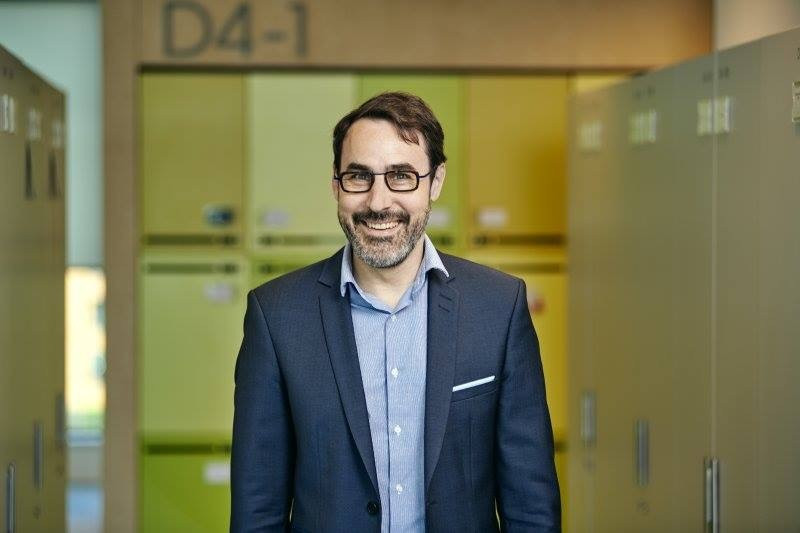Lire l'article original en français dans le magazine Le Fil #5
Generative AI is a hot topic with the spectacular arrival of DeepSeek, the Chinese rival to ChatGPT, but its famous avatars are just the tip of the iceberg. AI covers a wide spectrum and opens up a host of possibilities in the corporate world. From the optimization of operations to strategic decision-making, not forgetting task automation, customization and innovation, AI is reinventing customer and supplier relations and teamwork. Let’s get an insight into some of its uses, the obstacles it encounters and the opportunities it opens up.
According to the 2024 AI Index Report1, 55% of organizations were deploying AI in at least one unit or function in 2023, compared to 50% in 2022 and 20% in 2017. But is it about to enter the mainstream? Not quite yet: “AI has been around for many years in some sectors,” explains Benoit Loeillet (MS15), an Associate Professor who is head of the emlyon business school Operation Data and AI Department. “In the case of generative AI, lots of companies are still at the exploratory phase, testing the feasibility of projects.” All eyes are on this type of AI which is capable of generating new content (texts, pictures, sound, videos). But this only represents a fraction of AI. “Gen AI is trending, it has created a “wow” effect, but it is not the be all and end all; we cannot yet fully measure its effects,” points out Jérémy Bon (PGE23), a data scientist in Carrefour’s AI graduate program. Predictive AI, based on data analysis, remains the most pertinent and valuable application for a retail chain like Carrefour. “It enables each store to make incremental sales gains by optimizing assortments and on-shelf promotions and by analyzing product cannibalization etc.” And it can even prevent theft at the till thanks to video analysis.
Automation of repetitive tasks
“The number one function of AI in companies is to automate time-consuming repetitive tasks managed by processes and boost productivity,” explains Benoit Loeillet. Unsurprisingly, operations management is the corporate function which benefits the most. In Amazon warehouses, AI-powered robot systems optimize product picking on the shelves and simplify packaging procedures and parcel sorting to ensure faster shipment and shorter order-to-delivery turnaround. Financial services also make use of AI “to automate risk assessment processes according to the borrower profile before granting a bank loan, for example,” continues Benoit Loeillet. “And lots of stock transactions are now automated on the trading floor.”
AI and the planet AI has a significant environmental cost. Electronic components are manufactured using rare earths which are increasingly a source of conflict on the global stage. Storing data and training AI models requires vast resources: “The big names such as Microsoft and Open AI are looking into investing in power plants. Data centers consume huge amounts of energy and water,” explains Benoit Loeillet. AI is not that green after all! |
Bespoke customer service
Marketing departments leverage customer data for profiling and personal recommendations. “Netflix suggests new films and series to its subscribers based on what they have already watched as well as many other parameters,” explains Benoit Loeillet. Charles Salustro (PGE17), a CRM AI Product Manager at LVMH, helps the companies in the Group - in particular Tiffany (watches and jewelry), Loewe (luxury apparel) and Loro Piana (cashmere) - with their customer loyalty programs. “We build tools in collaboration with the data scientists working in AI teams to help sales advisors be more productive and offer an enhanced and more personal customer experience.” At Tiffany, each sales advisor manages a portfolio of several hundred clients: it is impossible to stay in touch with all of them. AI compensates for this by generating targeted clienteling2 campaigns which generate personalized messages mimicking the tone and style of the brand. “These messages have a strong effect: they encourage footfall and increase sales.” At Celine, an AI algorithm - currently being tested online - offers customers new combinations of products which match their style based on previous purchases: “Customers click and engage with the brand: the conversion rate is higher.” For Loro Piana, an algorithm calculates an appetence score for each customer based on various criteria (recency, average shopping cart, last purchase etc.). “This makes it possible to identify ‘high-potential’ customers, i.e. who are inclined to make a purchase soon, in order to reach out to them.” Once again, it works: the conversion rate is higher as is the value of the shopping cart. Michelin uses AI to offer additional services to its customers. Meri Martirosyan (MSc23), a data scientist in the group is working on a tire assistant project: “It’s a generative AI which communicates with the users: it tells them when they need to replace their tires, advises which model to choose and gives details of local dealers.” The group is also developing a computer vision program with integrated AI which uses an image to evaluate tire wear, maintenance or end-of-life tire solutions: “This tool was developed by Michelin technicians for internal use but could ultimately be made more widely available to motorists who aren’t experts but want to check the state of wear of their tires.”

"The number one function of AI in companies is to automate time-consuming repetitive tasks managed by processes and boost productivity."
Innovation and disruption
AI also has a contribution to make regarding innovation. Charles Depaepe (EMBA23) is head of information systems in charge of digitalization and AI at Phytocontrol, a food safety analysis laboratory which helps its food service customers - retail chains and small manufacturers - certify the conformity of the products they sell. Phytocontrol has disrupted its market thanks to AI: “Our customers expect reliable results and a quick turnaround; we have managed to make significant time savings by digitalizing our production chain. One of the most critical tasks is interpreting results: following chromatography, the food is broken down into 450 molecules, 434 of which need to be analyzed. The AI algorithm can process 419 of them rapidly and reliability freeing up the technician to focus on the 14 remaining molecules which has led to a 90% gain in productivity and time saving. AI assists operators with all their tasks, suggesting they check any points where there might be a doubt. But, at the end of the day, a human being is the responsible for validation.” Phytocontrol is currently testing ways to use AI for other raw materials: water and cosmetics. AI also allows the laboratory to standardize its practices: “We offer single validation and interpretation software which works with all the different types of equipment supplied which makes life easier for our technicians and further reduces the risk of error.” Phytocontrol’s R&D is also partnering with the University of Nimes to harness AI to determine the provenance of food and validate protected designation of origin labels (PDO-CDO).
AI is also responsible for progress in the pharmaceutical industry. “Developing a vaccine is a lengthy process as it requires in vitro tests (in vials), in vivo tests (on animals) then clinical studies (on people) as well as pharmacovigilance tests before the go to market,” explains Thomas de Charentenay (PGE94), who is in charge of data governance for vaccine R&D at Sanofi. “Today, in silico tests make it possible to simulate the effect of molecules on virtual living organisms.” AI analyses the millions of pieces of data produced to identify a promising vaccine candidate early on in the process which could considerably speed up the development of drugs in the future.
"Deploying an AI model implies a huge overhaul of processes and operating methods."
Encourage the take-up of AI
The level of deployment of AI varies considerably from one sector to another. “Obviously, the tech firms and pure players (Amazon, Google) don’t count,” adds Charles Salustro wryly. The retail business (Walmart, Decathlon, Leroy Merlin etc.) is also well ahead of the game as are the banks and insurance companies: their maturity is due to the sheer quantity of data they possess.” Jérémy Bon agrees: “With 3 billion transactions a year, Carrefour has one of Europe’s biggest data lakes. AI drives growth and is a major source of economies of scale in the retail sector which is highly competitive.” The luxury business, in particular LVMH, has taken AI on board even if it is not the most high-tech: “We sell exceptional products, crafted in a workshop. It would be difficult for us to be 100% AI due to the special relationship we have with our customers,” explains Charles Salustro.
The size of the company is not always an advantage: “Big groups may have more human and financial resources at their disposal but deploying an AI model implies a huge overhaul of processes and operating methods which is not always simple for large organizations,” notes Benoit Loeillet. “As a general rule, the lack of a digital culture is one of the main obstacles to change.” That is why it is so important to have key sponsors on board internally. “Our AI projects were initiated by the CEO and scientific research department. This type of support is crucial as the ROI of AI is difficult to quantify,” points out Charles Depaepe. At Carrefour, the main sponsor is Alexandre Bompard himself: “His strategy is to turn the group into a digital retail company,” explains Jérémy Bon. “Each business unit (warehouse, store, etc.) has its own digital factory which forms an interface between the functions and the tech teams.” For Charles Salustro, there are three obstacles facing AI: human, organizational and technical. “Buy-in from the teams is the main hurdle. Our sales advisors are highly qualified and have a strong engagement with the brand; the idea is to demonstrate that AI tools are not there to take their place but to free them from repetitive tasks so they can focus more on customers.” Proper communication is of the essence.
"An AI project is 20% algorithm and 80% project management."
“Training is available to everyone in the Group. Every year, a Business of Tomorrow event is held at head office, it’s a sort of VivaTech for LVMH which presents use cases from our companies. The Group’s tech partners come and talk to the operators and the senior management team.” In organizational terms, the difficulty is aligning the retail teams in the stores, the clienteling teams who create marketing strategy at head office and the digital teams: “An AI project is 20% algorithm and 80% project management.” The last obstacle is technical. “We have lots of customer data, but the quality is not always sufficient to populate the algorithms.”
Alumni with an AI bias
|

Data: the holy grail
Obtaining good quality data can be quite a challenge. “We need to make sure that data is collected properly and is reliable and complete. If you put rubbish in your AI model, then rubbish will come out... and you will base your decisions on corrupt results,” says Benoit Loeillet. But generating data on an ad hoc basis is no simple matter. According to Thomas de Charentenay: it’s all a question of management; before involving AI, managers have to make their teams aware of the complexity of the value chain. In the pharma industry, data created internally must be correctly organized right from the R&D stage if we want to obtain data which complies with the health authority regulations at the end of the chain. Each person needs to think about the interoperability of the data they produce for the next link in the chain.” This is far from being the norm in all industries, often because management systems based on individual performance are not conducive to a collective mindset: “In this context, the challenge is for everyone to upload their data into the cloud as quickly as possible bearing in mind it needs to be exploitable downstream.” Claire Launois (PGE20) is Data Product Manager for Decathlon sports applications (Decathlon Outdoor, Decathlon Coach, Kiprun Pacer and Decathlon Ride); her job is to handle the hidden part of the iceberg: “I filter and reprocess the raw data from our apps so that data scientists have access to standard data which can be exploited over the long term.”
"It is essential for professionals and data experts to work closely together to evaluate the pertinence of data and ensure they are a reliable tool to drive decision-making."
Benoit Loeillet confirms: “It is essential for professionals and data experts to work closely together to evaluate the pertinence of data and ensure they are a reliable tool to drive decision-making.” Claire Launois has a liaison role: “I make sure that the technical team is kept informed of the needs and constraints of the business. And I advise the business so that they are aware of data governance and organization issues. It’s a sort of dual advocacy!”
AI on the curriculum of emlyon
|
Regulations and security
Regulations tend to slow down AI projects, not only in the pharmaceutical industry. Michelin’s tire assistant, for example, was initially developed in four non-EU pilot countries (UK, Mexico, Australia and India) due the strict GDPR3 rules. “We work iteratively, performing tests in less sensitive regions before wider deployment,” explains Meri Martirosyan, pointing to the importance of respecting regulatory boundaries. Another issue to bear in mind is data security. Carrefour was one of the first retailers to introduce a public chatbot and – bingo - one of the Group’s flagship projects is the implementation of a chatbot for all employees: “Unlike ChatGPT, it offers a secure environment with less risk of data leaks,” notes Jérémy Bon.
To wrap up, Benoit Loeillet points out that AI is not free of bias: “It’s impossible to eliminate totally; you need to factor it in when making decisions.” Lastly, he insists that we should not forget that not everything can be automated even in a corporate environment. “Data exists which is not and cannot be measured such as human experience and expertise which are difficult to transpose into AI models.” The challenge is combining human qualities such as intuition, creativity and emotional intelligence with the objectivity and computing power of AI systems. The good news is - Homo sapiens is still in charge!
1- The 2024 AI Index Report (Standford) – https://bit.ly/4izD2Ms
2- Marketing strategy intended to actively secure customer loyalty by remaining in constant contact.
3- General data protection regulation.

Benoit Loeillet (MS15)
emlyon business school

Jérémy Bon (PGE23)
Carrefour

Charles Salustro (PGE17)
LVMH

Meri Martirosyan (MSc23)
Michelin

Charles Depaepe (EMBA23)
Phytocontrol

Thomas de Charentenay (PGE94)
Sanofi

Claire Launois (PGE20)
Decathlon
Lire l'article original en français dans le magazine Le Fil #5

Commentaires0
Veuillez vous connecter pour lire ou ajouter un commentaire
Articles suggérés


